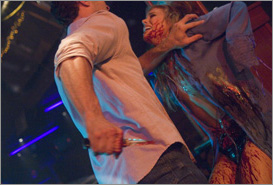|
From HouseofHorrors.com Recent Reviews This is no simple disease – it’s genuinely disturbing. One of the story’s most horrific moments takes place on a plane, where a horrified female passenger is efficiently silenced by a flight attendant. A man next to the deceased mutters, “Thank you.” Many Masters of Horror have featured wanton violence against women, but this is the first time the misogyny hits hard. Against this grisly backdrop, one family struggles to survive. Conveniently, this family includes three scientists, one an epidemiologist. The three we come to focus on are Alan (Jason Priestley), Anne (Kerry Norton), and Amy (Brenna O’Brien). While Alan hopes to inspire action from the government, Anne and Amy help other women in increasingly hostile territory. Meanwhile, grandmother Bella (Linda Darlow) makes a visit to the first quarantine zone in Florida, where the death toll has reached over a thousand. In the film’s best scene, Bella interviews Rodney (Nelson Carter Leis), a man responsible for at least two deaths. He describes what happened with cold clarity. The scene is tense, and it immediately establishes the cruelty of the stakes involved. As Rodney describes what happens, he slowly recognizes the threat posed by the female interviewing him. He evinces a religious bent, mentioning the danger of Eve in the garden of Eden. Religious mania is only one of the thematic elements that features. The American government is efficiently mocked. One of the first cases of mass death is attribute to Islamo-fascism. Bella repeatedly warns her family, with little subtlety, that we are the pest in Mother Nature’s garden. The tree-hugging is a bit much at times, especially in lieu of what happens at the very end. What happens won’t surprise most viewers, but it sadly raises more questions than it can answer, and it destroys much of the satisfying mystery Hamm creates from the original story. It also betrays the underlying logic – if we’re the pest of Mother Nature, couldn’t she handle us on her own? I’d rather we didn’t see exactly what was responsible for the violent strain of behavior. There are a few other logical problems with the story. We never learn exactly how the disease is contracted and spread, leaving us to wonder why some characters last longer against the disease than others. Additionally, there's a scene toward the end where I wasn't sure why someone was driving away from a cabin, when they ended up right back where they were. These are legitimate questions, and not nitpicks. The creative team should've gone back and given this tale one more tightening. Joe Dante directs this film more aggressively than Homecoming, which was effective, if a bit static. Here, the camera is frequently tracking and jumping from character to character, and the larger budget allows many of Dante's more populous visions to be realized. This episode contains more nudity and violence than his last entry, and the climactic scene in hospital is full of creepy imagery, not least of which is a penitent priest who kills women and then gives them last rites. What ultimately makes the film work is the connection to the three main characters. While Priestley won't blow anyone's mind, he makes Alan a believable character. His interactions with Anne feel genuine. As the plague spreads, he realizes the threat he poses, so he tells Anne and Amy to head north. Anne proves a stronger woman than suspected. She becomes the new protagonist, and that is a welcome development. A lot of women in horror become de facto heroes, by simply being survivors. Anne is adept and smart, and compassionate. At the same time, she is a fighter, and, when the situation demands it, she steps up to the plate and becomes just as aggressive as the threatening males. It's through her eyes that we follow the last half of the story, as it moves into bleak terrain, but Kerry Norton's spirit keeps us hopeful. If this truly is the end of humanity, thank the stars the last moments are given to her. © Copyright by HouseofHorrors.com |
